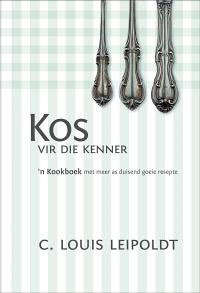
Kos vir die Kenner: n Kookboek met meer as duisend goeie resepte - C.Louis Leipoldt
Check my rate
| Main centres: | 1-3 business days |
| Regional areas: | 3-4 business days |
| Remote areas: | 3-5 business days |

| Main centres: | 1-3 business days |
| Regional areas: | 3-4 business days |
| Remote areas: | 3-5 business days |
Published by Human en Rousseau, 2011, hardcover, Afrikaans text, condition: new.
The young Leipoldt's companions and entertainment were books, and also their domestic help, who allowed him to lend a hand in the kitchen. From her he learned about pinang meat and swallow stews. Leipoldt ended up as a young man in London, where he studied medicine. To earn an extra, he works in the Carlton Hotel under the strict eye of the famous chef Escoffier. He clearly proves himself very quickly, because Escoffier takes him to cook in Buckingham Palace. Leipoldt travels, collects exotic cookbooks, and comes into contact with a Frenchman, André Louis Simon, who lived in England and wrote more than 150 books on food and wine. They become kindred spirits. All this eventually led to the publication of Food for the Connoisseur in 1933. As someone who grew up with Leipoldt on the bedroom wall and Polfyntjies vir die Proe in our kitchen, I approached the recent issue of Kos vir die Kenner almost with old-fashioned nostalgia. And let me admit, I didn't necessarily read it after the recipes. I was, like Toeka's time, seduced by his use of language: "peanut" for "peanut", "equally large" for "equally large", "klipkous" for "perlemoen", "lebbetje" for a loose piece of raw meat, and "stir up" instead of "sauté" or "pan fry". How nice is it to talk about "a little chopped parsley", a "pinch of saffron" and a "clove of garlic"? In Food for the connoisseur I read again about "eight-hour dishes" and "panade".To come across words such as "water onions", "jackals food", "kambro", "wild anise root", "wild plum", "amatungula", "duinberries" and "moeples" in his section on "Field food" is like standing under a mountain waterfall on a sweltering day.
In the section on "Vegetables" I find life philosophy: "Older vegetables should always be steamed or cooked slowly with very cold water. Young, fresh vegetables can be cooked quickly in boiling water, with the lid on the pot! Also in "Poultry, birds, game": "Tame birds should not hang for long, they should never have a smell; wildfowl and game, on the other hand, can hang around much longer and are sometimes better if it's a little noble .From the outset it is important to learn exactly what a bouillon (beef soup), consommé (double strength soup), veal consommé (the French blond de veau ) and chicken soup are.
In the section on sauces, Leipoldt quotes the famous cook Soyer: "A sauce is to the art of cooking what grammar is to a language." And I decide that's what I want to learn, that grammar - only to be put in my place by Brillat-Savarin, who had it that waysaid: "You can be trained to bake, braise and cook, but the good sauce maker must be born as such."
One gets the need to repeatedly call someone closer to whom you can read something from the book aloud. "Ragout of little birds" (p. 324) is the title of a poem? One must know about Ghoe coffee, made from the seeds of the wild almond (p. 442), and know about "Pope's wine", sweet almonds and bitter almonds (what else?). And how delicious is the description of a "Quenell filling" (p. 227): "It is actually made from rabbit meat, with the addition of a boiled udder from a heifer. The flesh of the udder is pounded in a mortar; panade (breadcrumbs soaked in water, pressed and mixed with butter) is added And so on and so forth.In the section on "Fish". When was the last time you stuffed a whole fish (à la St Menehould) with a veal filling? Sew it up and put it in a pan. Cut it deeply with a knife on both sides up to the spine, two or three cuts. Pour over a good half pound (250 g) of melted butter, pepper, salt and half a cup of oyster water
I quote Peter Veldsman again where he sums up the book so well: " Food for the connoisseur is not a practical cookbook, but rather a signpost, a stimulus to the wonderland of local food as well as the cooking methods of European and other food gurus. It remains a dream book from which you can dream undreamed food dreams."